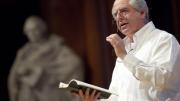It’s not immediately clear, as William Kentridge starts to play an excerpt from his 2005 animated film rendition of The Magic Flute, how the 1791 Mozart opera connects to the topic of his second Norton Lecture, “A Brief History of Colonial Revolts.” On screen, a metronome with a Masonic Eye of Providence in place of a weight ticks back and forth, out of time with the music. A vaguely hieroglyphic bird eats the eye, grows tall legs, then walks away. The motifs of presence and erasure that characterize many of Kentridge’s films occur here, but in a less pronounced manner. A negative image—a silhouette, white on black—of a man in a high collar (perhaps Kentridge himself?) conjuring birds appears. That man plays with elements of the animation from within the film. Finally, a wheel of architectural drawings spins before the lens of the camera, and with a resolute cadence in the strings, the overture ends and the lights come up.
The images and music seemed a world away from stories the filmmaker had been telling minutes earlier. He spoke about John Chilembwe, a Baptist minister and leader of a rebellion in Nyasaland (now Malawi) in 1915, following his refusal to participate in World War I, a war in which he had no stake, and in which Africans ultimately had no hope of improvement or betterment. The British brutally suppressed his revolt, killing him and his followers. Kentridge also sketched a brief history of a Herero insurrection in what had been German Southwest Africa—“the first German genocide of the twentieth century,” he noted. Skulls of the Herero were shipped to Berlin, where they were skinned, boiled, and catalogued for taxonomical purposes—an attempt to construct a latter-day Great Chain of Being.
And, he said, these are not merely cautionary tales from history: “This is where we are still embedded—in questions that surround the drone attacks in Afghanistan, or the remarkable work that Médecins Sans Frontières is doing in Somalia.” He linked back to his first lecture, in which he interpreted the allegory of the cave in Plato’s Republic as a metaphor: the philosopher, with privileged access to reason, “had the moral right and obligation to return to the cave, and take people from the darkness to the light”—even if that required using force. “In this lecture,” Kentridge resumed, “we will continue this examination of the metaphor of light and darkness, of lightness dissipating illusion and ignorance, and we will look at a later version of Plato’s metaphor—at the eighteenth century of Enlightenment.”
He laid out his understanding of The Magic Flute as a characteristic expression of an Enlightenment-era paradigm: a vanquishing of darkness, in the person of the Queen of the Night, by the forces of light and sun, the high priest Sarastro. At that point, he said, “We are at the end of Plato’s myth.…Sarastro, Plato’s philosopher-king, combining a monopoly of wisdom with a monopoly of power and violence.” Of course, violence and control are not overt themes of Mozart’s work. Kentridge noted the irony, in hindsight, of its performance at the Staatsoper Berlin in 1938—a detail he revealed after playing a recording of Sarastro’s aria from that performance.
Kentridge turned momentarily to the process of producing the striking white-on-black animation for his production of the opera. It required experimentation to find a method that would work: “There are two ways of making white lines on a black background. You could draw with white chalk or pastels on black paper,” but this results in crude, rough lines. Alternatively, you could draw black lines on white paper, and then invert the image—which is precisely what he ended up doing. “It was in this moment of inversion…that the image of the production was born—the metaphor of the photographic, the possibility of the stage as the chambre noire.”
The film metaphor clicked the production—and its reevaluation of The Magic Flute—into place, Kentridge said:
In the Temple of the Sun called for [both] by Plato and by the end of the opera, it is a happy ending, but it is also completely overexposed film. It is the light of the projector when the film is running through it, and the reel of the film runs out, and there’s nothing more to say. For us, the clear light of the sun can be thrown into question both by the shock of imagining Sarastro’s aria in the swastika-bedecked Staatsoper of 1938, and also by so much of the post-history of Mozart’s opera.
He argued that “Robespierre, with his combination of the assumption of wisdom in the name of rationality and the violence of terror, sets the stage. And every tyrant since then would have described himself as a Sarastro—and by extension the philosopher-king from Plato’s cave—using whatever means necessary to drag, to pull, the unenlightened into the sunlight of the Soviet Union, of Pol Pot’s Cambodia, of the American way of life in Vietnam.”
This reasoning, he explains, is why he sees colonialism as the logical culmination of Enlightenment thought—and why that thought can be so dangerous. “Every act of enlightenment—all ambitions to save souls, all the basic impulses—is so dogged by the weight of what follows it, the shadows, the violence that has accompanied the Enlightenment. The colonial project in its own description of bringing light to darkness is a gruesome working out of Plato’s cave.”
If Kentridge’s lecture was hard to follow, that was not by accident. Although he said he sees the appeal of “the more elegant clarity of a whole blackboard full of equations that reduce to a single line,” he purposely structured his lecture with gaps and non sequiturs: “It is in these gaps and incompletions that we make the space where the work can emerge."









